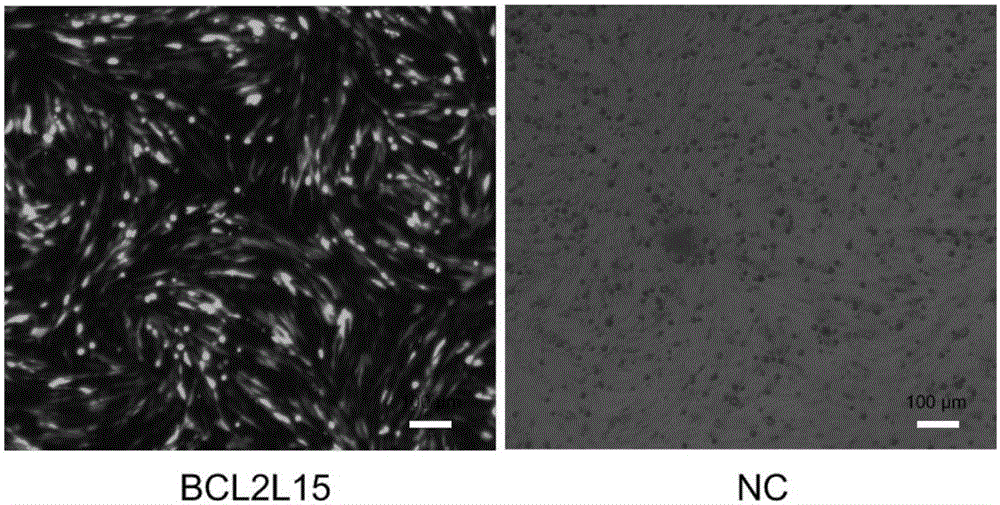Application of duck BCL2L15 gene in livestock and poultry for resisting avian influenza virus (AIV)
A gene and virus technology, applied in the application field of duck BCL2L15 gene in the anti-AIV virus of livestock and poultry, can solve the problem of breaking the balance between waterfowl and influenza virus, and achieve the effect of inhibiting replication
- Summary
- Abstract
- Description
- Claims
- Application Information
AI Technical Summary
Problems solved by technology
Method used
Image
Examples
Embodiment 1
[0050] Example 1 Obtaining the sequence of the full-length coding region of the duck BCL2L15 gene by means of molecular biology experiments
[0051] Referring to the duck genome reference sequence on the Ensemble website, and according to the transcriptome splicing sequence, design the duck BCL2L15 gene full-length CDS region cloning primer BF / BR, the sequence is as follows:
[0052] BF: 5'-CAATGACAACGTTTGAGGAACAGAC-3',
[0053] BR: 5'-GTAGTAAAACACTTCCTCTCAGTCA-3'.
[0054] Using the cDNA of duck spleen tissue as a template, NEB company's Q5 high-fidelity polymerase was used for PCR amplification, and the amplified product was recovered by gel and ligated to T carrier for sequencing. After sequence comparison analysis, it was found that the full-length coding region of the duck BCL2L15 gene is 483bp (SEQ ID NO.1), encoding a total of 160 amino acids (SEQ ID NO.2).
[0055] In this example, the full-length coding region sequence of the duck BCL2L15 gene was successfully clone...
Embodiment 2
[0056] Example 2 Transient overexpression of BCL2L15 gene in cells by cytology experiment method
[0057] 1. Construction of duck BCL2L15 gene overexpression vector
[0058] According to the coding region sequence of duck BCL2L15 gene, the eukaryotic expression vector primer eBF / eBR was designed, and the upstream and downstream primers were respectively introduced into MluI and PmeI restriction sites (underlined); in addition, the upstream primer was before the start codon ATG Introduce the kozak (box marked) sequence, and introduce the flag tag (box marked) at the C-terminus of the target gene. The primer sequences are as follows:
[0059] eBF: 5'-CG ACGCGT ATGACAACGTTTGAGGAACAGACGA-3',
[0060] eBR: 5'-GG GTTTAAAC TCA GTCATCCAAGTTTCTCCCATCCTCCA-3'.
[0061] The CDS sequence of the amplified BCL2L15 gene (as shown in the sequence table CDS) was introduced into the original vector PiggyBac-Xgene (the vector map is shown in figure 2 shown), the PiggyBac-BCL2L15 v...
Embodiment 3
[0066] Example 3 Verification of Duck BCL2L15 Gene Resistance to AIV Infection Using Cytological Experiments
[0067] 1. Duck BCL2L15 gene inhibits influenza virus replication
[0068] Transfected PiggyBac-BCL2L15, PiggyBac-Xgene empty vector (NC) and DF1 cell lines with good growth state were mixed with 2×10 5 Cells / ml were seeded in 12-well cell culture plates, and challenged after the cells were stably adhered to the wall. Two strains of H5N1 subtype avian influenza virus, namely DK / 49 and GS / 65, were selected for the challenge experiment, and the challenge dose was MOI=0.001, and the experiment was set to repeat independently in 3 wells. Cell supernatants were collected at 12h, 24h, 36h, 48h, 60h and 72h after challenge for EID50 detection. The cell challenge experiment was completed in the P3 laboratory of Harbin Veterinary Research Institute.
[0069] The challenge results showed that compared with the negative control group (NC), the duck BCL2L15 gene inhibited the r...
PUM
 Login to View More
Login to View More Abstract
Description
Claims
Application Information
 Login to View More
Login to View More - R&D
- Intellectual Property
- Life Sciences
- Materials
- Tech Scout
- Unparalleled Data Quality
- Higher Quality Content
- 60% Fewer Hallucinations
Browse by: Latest US Patents, China's latest patents, Technical Efficacy Thesaurus, Application Domain, Technology Topic, Popular Technical Reports.
© 2025 PatSnap. All rights reserved.Legal|Privacy policy|Modern Slavery Act Transparency Statement|Sitemap|About US| Contact US: help@patsnap.com



